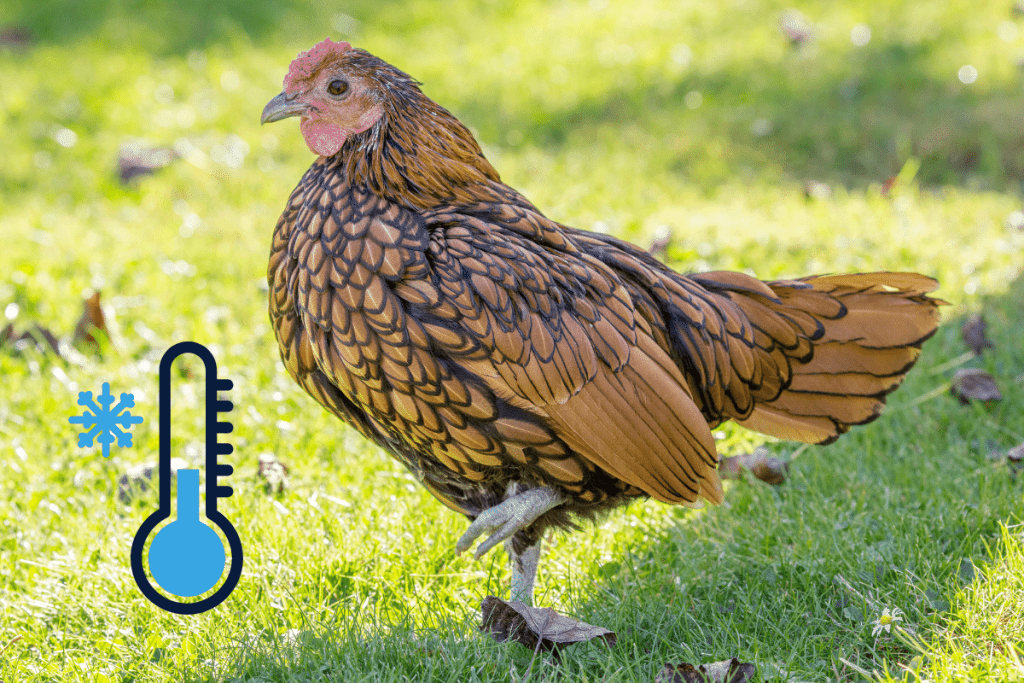Sebright chickens are renowned for their beautiful plumage and subsequent value as show birds.
But the truth is, they are not your typical laying hen and require some special care.
Key Takeaway:
The Sebright chicken does well enough in the winter but keeping a heater in the coop during the coldest months is best for them. Their distinct lace plumage shields them from the worst of the cold, and their rose combs put them at low risk for frostbite. Still, they were not bred to be hardy, and acting cautiously is safest.
Being a true bantam, it is no surprise this breed of chicken requires some extra attention.
Keep reading to learn more about caring for your Sebright chicken and getting all your birds through the coldest months of the year.

Table of Contents
ToggleDo Sebrights Do Well in the Winter?
Sebright hens are not winter layers.
They tend only to lay in the springtime.
However, they can live in cool climates with some artificial heat and do perfectly fine.
Despite their diminutive size, Sebright hens are capable of sustaining a lot once they reach maturity.
The important thing to remember is how fragile Sebright chicks are.
Their already distinctive plumage has not yet grown thick enough to help regulate their body temperatures in extreme cold.
During the first 7-12 weeks of life, protecting your baby chicks of any breed is crucial.
But keep in mind the fragility of the Sebright chick.
The mortality rate for this chicken breed is high in those initial weeks of life.
Heat lamps or other heating methods are essential to their survival, especially if you live in a cold climate or purchase your chicks in the winter.
Once your birds are old enough to stop using a heat bulb, it is still important to have an insulated coop.
This is good for all your gorgeous birds, even those breeds like the Brahma or Orpington, known for being hardy.
The Sebright may surprise you with their hardiness, but they will appreciate any help you give them to keep warm.
Frostbitten Combs
What makes the Sebright a tougher winter bird is its rose comb.
While its area seems large, this comb is short and close to the head.
So, it isn’t as easily nipped by the cold and frostbitten.
For many breeds, roosters are the more susceptible sex to frostbite due to their larger wattles and combs.
Conversely, most breeds’ roosters are considerably larger than the hens, which gives them an edge in the colder months.
Sebrights stand out in these regards.
The roosters have slightly larger wattles than the hens, but their combs are mostly the same size.
Males and females of this breed nearly identical.
To get an accidental rooster would not be a big deal with this breed.
The males share the hens’ friendly but active nature, and their needs are virtually identical.
The only difference is the males won’t lay a single egg, whereas the hens lay during the spring.
Do Sebright Chickens Get Sick in Winter?
While Sebright hens are no more susceptible to respiratory or other cold-related illnesses, they are more vulnerable to Marek’s Disease than most breeds.
Marek’s disease can wipe out an entire flock of previously healthy chickens if it is not brought under control quickly.
Before buying Sebright chickens, learn as much as possible about this illness and how to prevent it.
Why Aren’t Sebrights as Hardy as Other Hens?
Sebrights aren’t as cold hardy as some other chicken breeds for the same reason they don’t make good layers:
They weren’t bred for it.
The Sebright breed is of British origin and was initially developed by Sir John Saunders Sebright in the early 19th-century agricultural scene.
When John Sebright set out to perfect this breed, his goal was not egg production, meat production, or even resistance to illness or extreme temperatures.
Further Reading: Sebright chicken egg guide and FAQ
His goal was to create the most beautiful bird possible.
And you might say he succeeded, considering Sebright roosters and hens are still commonly used in poultry exhibitions two centuries later!
The silver-laced feathers of the Sebright bird make them stand out, and their adventurous but friendly nature endears them to everyone they meet.
All this, though, comes at the cost of being a consistently healthy bird, a strong egg-laying bird, or an effective meat bird.
If ever you find yourself growing frustrated by your hen’s limitations, thank John Saunders Sebright.
However, when you admire your bird’s feather color and laced plumage or appreciate its friendly and curious nature, you have the same person to thank!
What Is the Ideal Environment for Sebright Chickens?
Sebrights are rather picky when it comes to the climate where they live.
They do best in mild weather, which is why they lay in the spring and rarely in other seasons.
Extreme cold is not good for them, but they are no better suited for extreme heat.
Sebright hens were not bred to have an impressive egg size or above-average laying abilities.
Their miniature size did not make them good layers in any climate.
They are adaptable enough to do alright in a hot or cold climate, provided you help them regulate their body temperature.
Using a heater or extra coop insulation in the winter when temperatures drop (especially if they get below zero in your area) is important, but so is providing shade, cool water, and good spots for dirt bathing in the summer.
Another environmental factor to consider is space.
Sebrights are sometimes flighty birds.
But more so, they are adventurous chickens by nature.
They are an excellent chicken to free range.
But if you fence them into a chicken yard, give them space to roam and maybe someplace up high to perch.
How useful was this post?
Click on a star to rate it!
We are sorry that this post was not useful for you!
Let us improve this post!
Tell us how we can improve this post?
